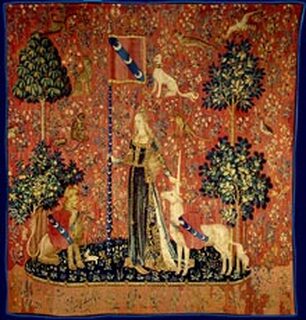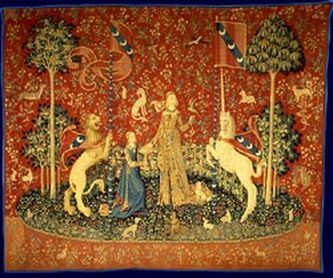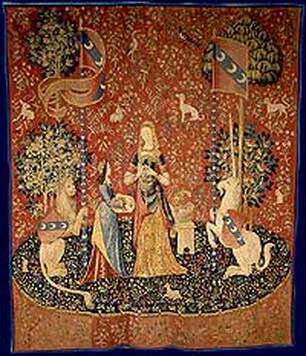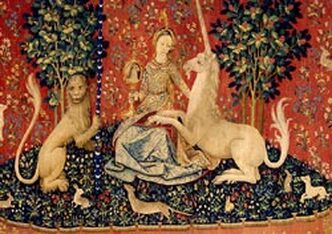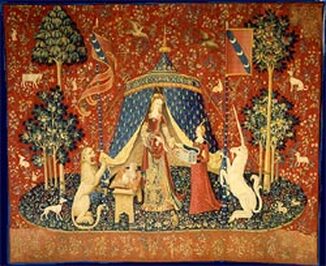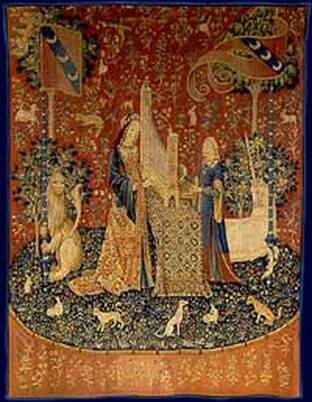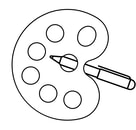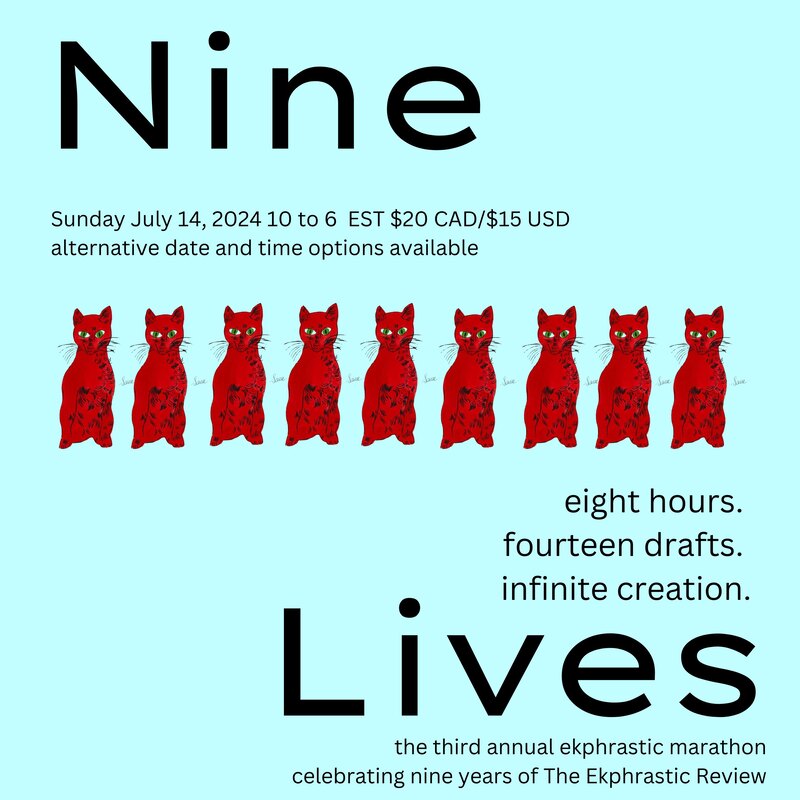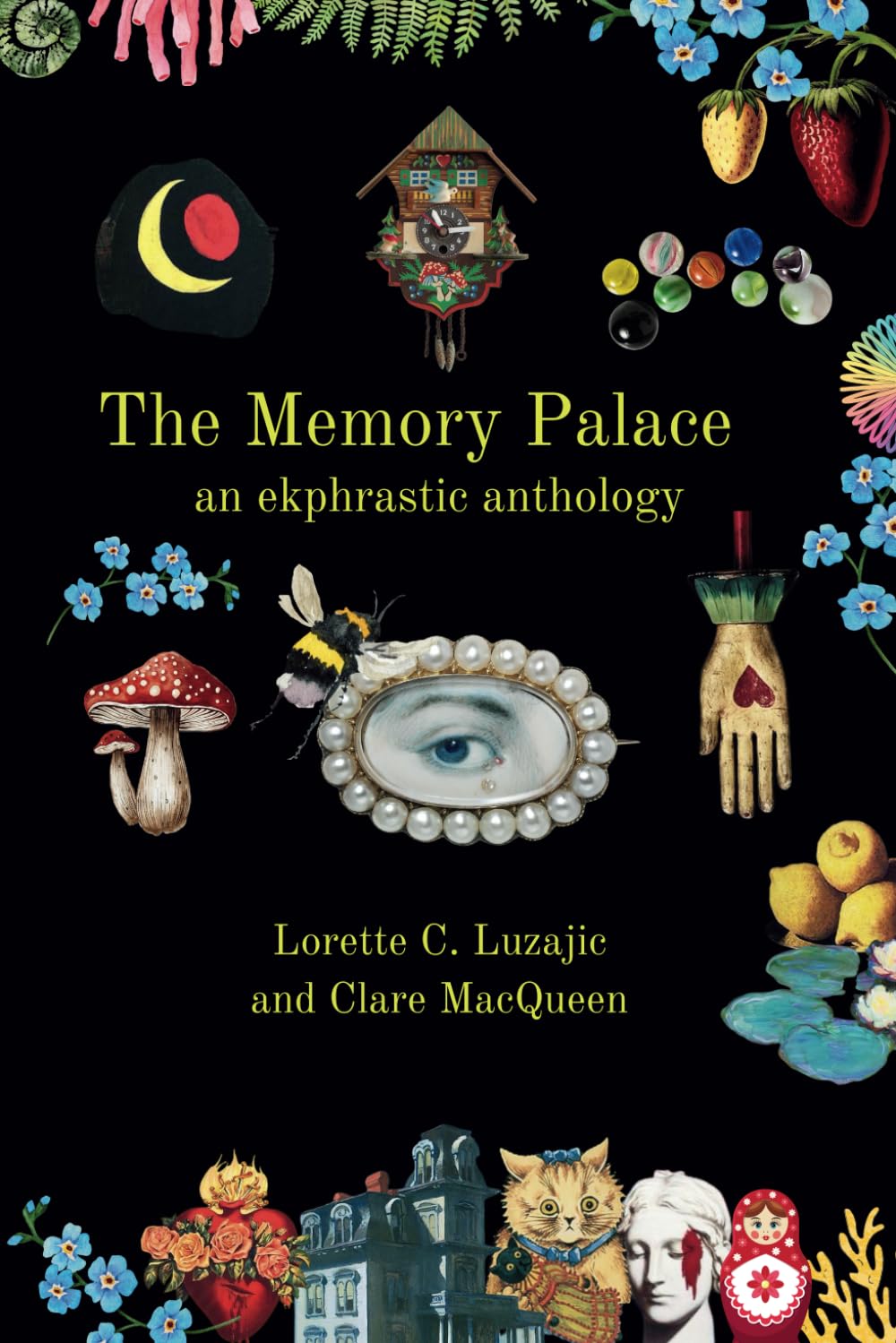|
On The Lady and the Unicorn Tapestries After the six 15th Century tapestries commonly regarded as allegories of the five senses and a sixth sense of the heart. The Cluny Museum, Paris I. The Encounter
After the pious saints and tokens of war, dulled paint, tarnished metals in exhibits below, the tapestries, huge and glowing, float in the dimly-lit room at the top of the stairs. They astonish. How delicious to frolic with brocaded ladies, with bright flowers and beasts and birds! Though enchanted, I sense beneath the posed scenes, implications. II. The Monkey In only four of the six is the monkey allowed. The artist knew well to mind the traditions, hierarchy of senses being sacred and known. Thus, the noble Sight and Sound, gateways to God, could not include this creature of sin. He serves as our proxy, this foolish debasement in near-human form. But see him relish the berries of Taste and the pungent carnation of Smell! And notice his stare over the shoulder, encountering us in his naïve boldness, at center-front in Mon Seul Desir as though to see our reaction to this puzzling tableau, to tattle a tale back to artist and weaver. His mischief expected, of course. But how cruel is his bondage in Touch! As the lady fondles the horn of the tamed unicorn and grasps the patron’s banner, he sits disheartened, chained to a stone, his fellow ape in a belt of confinement. And other animals, too—the genet and dog and the fox—all collared, subdued. Only the soul-symbol heron flies high, free from the cuffed falcon, and the pheasants upon which courtly vows are made, arrive freely on time. Rabbits scamper in abundance. Beneath the nuptial perfection of the orange tree-- chaste blossoms and ripe fruit together-- the lordly lion turns to us with a smile. And what of the Lady, solemn, distracted? Eyes wary, she poses weighted with thick robes, trussed with chains, held with stones. III: The Four Trees Of course, the artist would use four trees —four seasons, four directions, four humors, four winds-- Symbolic meaning understood, balancing compositions with calming green against rampant fields of scarlet. The holly was a given-- long standing for the coy unicorn and the moon in the waning half of the year, but also for the passion of Christ with its thorn-spiky leaves, its blood-red berries, and in its winter greenness, unending life. And the oak, too, was required. Ever the tree of the lion, the king of the forest, the sun in the waxing half. These two bore the heavy load of oldest legends, deeply felt in Druid blood. The orange tree was symbolic perfection for those panels that hinted at marriage, white blossoms, full-fleshed fruit: the chaste and the fertile. But the fourth choice is a mystery. Why the pine? True, its whirling cones held pregnant seeds. (Some carried these as charms.) But other trees wield procreation magic. Why not the birch with her healing magic, powers of conception? Or what about the yew and the willow with their rebirthing and moon magic? The chestnut’s chastity, the elm’s fidelity? Medieval hearts adored these trees. The artist chose the pine. The reason, perhaps, is not of the flesh, but of the soul and the mind. See in the sixth tapestry, Mon Seul Desir, how the pine, along with the most-holy holly, anchors the opened tent, the heart, internal sense revealed. For the pinecone base bespeaks the “third eye,” enlightenment’s center, and its needles held the scent that dispels guilt. Burn them to purify the home. Bathe with them for magical cleansing. And so the pine signals the lady’s sanctity. She can allow her soul’s display, guiltless after serving the lusty senses, properly enlightened at the dawn of the Renaissance. IV: The Flowers Fields of flowers—millefleur-- in peak bloom. The April violet, the June rose nod at once full-blown in a season that could never be. Separately woven with no distance confusion, each discrete flower claims its sovereign worth. For this garden of love: periwinkles, roses, and pink carnations for wedding crowns. Gillyflowers for constancy, forget-me-nots for sincerity. But the garden is sacred, as well, and belongs to Our Lady, the Virgin. She summons the watchful unicorn with the purity of white roses, with love, red-rose rich as Christ’s blood. Lilly-of-the-valley, foxgloves, columbine, daisies, and violets are her flowers, as all would have known, and thrive in each tapestry field. Warming cold walls of ancient castles, the tapestries contented hearts both romantic and saintly with flower-strewn meadows of red. V: The Hands The ladies’ hands have no knuckles, no tendons, no blood. Vaporous like those of elongated saints, pure like the wings of small doves, they yet perform earthly tasks, caressing the horn of the adoring beast, twining flowers into a lover’s chaplet, playing the organ. Fingers pluck sweets from a bowl and make a dainty perch for the bird. All moves illumine pleasures, pleasures served to others. One lady touches but is not touched. One feeds but does not eat. One fashions a flower wreath for another but does not (like the monkey) savor the heady fragrance of carnation and rose all about her. One offers music for the listeners, another, a mirror for the unicorn, and finally, after opening the privacy of her heart, the lady’s hands in the sixth panel cast aside all delight in her own possessions in her own pleasure. And then she is wholly the servant whom the artist, the designer, the dyer, the weaver, and the patron expect her to be. Clela Reed Clela Reed is the author of seven collections of poetry. Recently Silk (Evening Street Press, 2019) won the Helen Kay Chapbook Prize and then the 2020 Georgia Author of the Year in chapbook competition. A Pushcart Prize nominee, she has had poems published in The Cortland Review, Southern Poetry Review, The Atlanta Review, Valparaiso Review, The Literati Review, Clapboard House, and many others. A former English teacher and Peace Corps volunteer, when not traveling or shooing deer from her garden, she lives and writes with her husband in their woodland home near Athens, Georgia.
0 Comments
Your comment will be posted after it is approved.
Leave a Reply. |
The Ekphrastic Review
COOKIES/PRIVACY
This site uses cookies to deliver your best navigation experience this time and next. Continuing here means you consent to cookies. Thank you. Join us on Facebook:
July 2024
|
